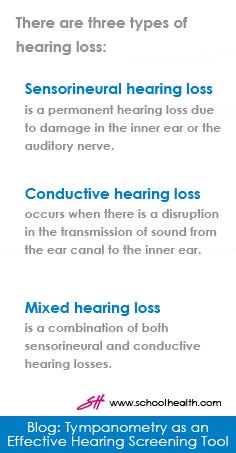Tympanometry as an Effective Hearing Screening Tool
By Cassie Tuell Au.D., CCC-A

The most common developmental disorder identified at birth is hearing loss1. The prevalence of hearing loss also increases in school-aged children due to late onset hearing loss, acquired hearing loss, and hearing loss that has not been previously identified. According to the American Speech-Language-Hearing Association (ASHA) in its 1997 Guidelines for Audiologic Screening article2, identification of hearing loss or hearing related issues is vital in order to minimize the impact hearing loss can have on language, educational, cognitive, and social development as well as socioeconomic impact.
There are three types of hearing loss: sensorineural, conductive and mixed. Sensorineural hearing loss is a permanent hearing loss due to damage in the inner ear or the auditory nerve. Conductive hearing loss occurs when there is a disruption in the transmission of sound from the ear canal to the inner ear. Mixed hearing loss is a combination of both sensorineural and conductive hearing losses.
Conductive hearing losses are often caused by ear infection or other middle ear pathologies and can cause significant temporary hearing loss. Young children are more prone to middle ear problems due to anatomical immaturity. Bacteria from the throat are more likely to work their way up into the middle ear space. Typically, conductive hearing losses are not permanent but can be resolved through medical intervention or spontaneously by simply watching and waiting.
In order to identify hearing loss that was not identified at birth, hearing screenings are recommended by the American Academy of Pediatrics (AAP) as an ongoing preventative measure from infancy through adolescence. School hearing screening guidelines recommend pure tone air screening as the intial tool to identify hearing loss in school-aged children. Additionally, it’s recommended that tympanometry be performed with pure tone audiometry for preschool through first grade, or as an immediate rescreening method for all school-aged children who do not pass the pure tone audiological screen.
Tympanometry has been a successfully used method for assessing middle ear pathologies since the 1970s. Despite its success as screening tool, tympanometry is often underutilized or misused by school districts throughout the United States. The purpose of this article is to explain what tympanometry is and its value when used in conjunction with pure tone audiometry. Tympanometers test the status of the middle ear by applying positive and negative pressure in the ear canal. The pressure variation is used to verify eardrum movement and how the middle ear system sends sound to the inner ear. Tympanometry is not a test of hearing. It’s a test of mechanical function and can determine whether or not there is fluid in the middle ear space, the size of the ear canal and verify that PE (pressure equalization) Tubes are functioning properly.
The purpose of school hearing screenings is to identify the presence of sensorineural hearing loss, which has previously gone unidentified. Use of tympanometry in conjunction with pure tone screening will differentiate children who are likely refering due to middle ear pathology from those who have permanent hearing loss. When a child refers the pure tone audiometry screening, a tympanometry screening should immediately follow.
To perform tympanometry, a visual inspection of the ear should be performed using an otoscope. Following the otoscopic evaluation, the appropriate sized ear tip must be selected in order to achieve a seal in the child’s ear canal. The evaluation is an automated pressure sweep that takes about five seconds per ear. If the child does not pass the tympanometry screening, rescreening should be performed in 6-10 weeks, unless other medical concerns, such as pain or discomfort, accompany the abnormal tympanometry results.
When considering which tympanometer is right for the school district, there are several things to consider. Aside from cost, durability and portability are typically the two most important factors considered by school districts. There are several brands that offer portable tympanometers with rechargeable batteries making them easy to tote from school to school.
Hearing screening in the school setting is important to detect hearing loss in early childhood and early adolescents. The gold standard of hearing screening is pure tone audiometry, but other tools such as tympnometry should be considered as equally important when monitoring children with middle ear effusion or other middle ear pathologies.
Tympanometry is a quick, painless evaluation, and is not sensitive to movement or background noise; furthermore, tympanometry gives a lot of great information on the middle ear status of each child in the screening program. The most effective screening protocols will strive to identify and differentiate between potential permanent and temporary hearing loss.
References:
1. White, K. 1997. The scientific basis for newborn hearing screening: Issues and evidence. Invited keynote address to the Early Hearing Detection and Intervention (EHDI) Workshop sponsored by the Centers for Disease Control and Prevention, Atlanta, GA.
2. American Speech‐Language‐Hearing Association 1997. Guidelines for screening infants and children for outer and middle ear disorders, birth through 18 years. In Guidelines for audiologic screening, 15‐22. Rockville, MD: Author.